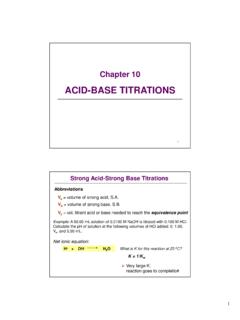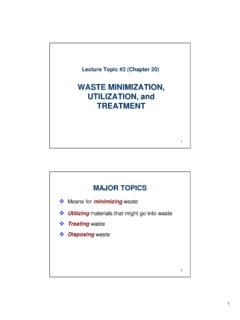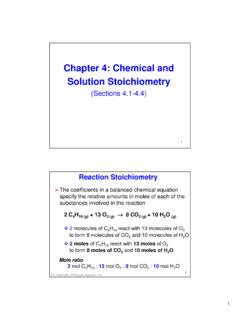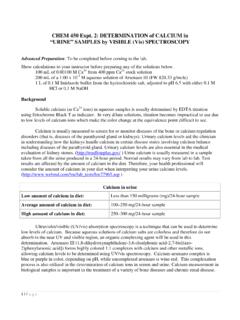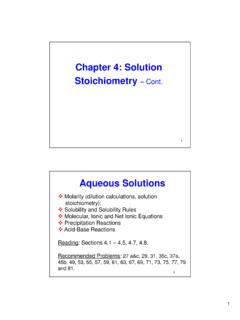Transcription of Chemistry of Natural Waters - Bridgewater State University
1 Chapter 10. Chemistry of Natural Waters 1. Terminologies Aquatic Chemistry deals with chemical phenomena in water Mostly Natural water (vs. water processed by humans). Hydrology = study of water Branches: Limnology deals with characteristics (physical, chemical and biological) of freshwater Oceanography deals with characteristics of the ocean 2. 1. Image available at 3. FIGURE 13- 1 Global pools and fluxes of water on Earth, showing the size of groundwater storage relative to other major water sources and fluxes. All pool volumes ( green) are in cubic kilometers, and all fluxes (.)
2 Black) are in cubic kilometers per year. [ Source: W. H. Schlesinger, Biogeochemistry An 4. Analysis of Global Change, 2nd ed. ( San Diego: Academic Press, 1997), Chapter 10.]. 2. The water (Hydrologic) cycle Image available at Key words: Evaporation Condensation precipitation Infiltration Runoff Transpiration 5. The Hydrologic cycle Cont. Source: Manahan, p. 56. Evaporation = involves vaporization of ocean water Condensation = process of water changing from a vapor to a liquid Clouds = water droplets suspended in air precipitation = water being released from clouds as rain, snow, sleet or hail Evapotranspiration = evaporation of water from the ground and release of water from leaves of plants (transpiration).
3 Infiltration = seeping of rainwater/melted snow into the ground 6. 3. Source: Manahan, p. 56. Runoff = surface flow of water that does not infiltrate the ground Drains into streams and rivers -> eventually empty into the ocean Runoff happens when: Soil is saturated with water from too much precipitation , or There is too much impervious surface (Ex. parking lots). 7. Human Impact on the water cycle As the population increases, so will our need to withdraw more water from rivers, lakes and aquifers Threatens local resources and future water supplies A larger population will not only use more water but will discharge more wastewater Guo Liliang/ChinaFotoPress/Getty Images The global water crisis affects the water supply all over the world, including China (right).
4 8. Image available at 4. Large cities, urban sprawl affect quality of streams and rivers More impervious areas ( roads, parking lots), less infiltration, more runoff into streams Runoff can contain a lot of contaminants, such as oil and garbage. This runoff often goes directly into streams The replenishing of ground water aquifers occurs at a slower rate Q. How do we protect our water resources? 9. FIGURE 13- 2 Global water supply in 2000 and projection for 2025. [ Source: R. Engelman et al., People in the Balance ( Washington, DC: Popular Action International, 2000) as reproduced in Nature 422 ( 2003): 252.]
5 ]. 10. Bottomline: Projected increase in water scarcity and stress problems 5. Global water scarcity Which areas of the world have water scarcity problem? Image available at 11. Role of Chemistry Understanding chemical reactions in Natural Waters (Chapter 10). Prevention or control of water pollution Purification of water for drinking purposes (Chapter 11). 12. 6. water Quality Parameters Definition: water quality parameters are properties of water that affect aquatic life 1. Temperature (T). Low T slows biological processes High T can be fatal; lowers dissolved oxygen (DO).
6 2. Transparency to light affects: Food for higher forms of life Growth of algae (more transparent, better growth). 3. Turbulence Affects mixing and transport of nutrients and waste Example: Planktons depend upon water current for their own mobility 13. water Quality Parameters Cont. 4. Dissolved oxygen (DO). O2 deficiency (very low DO) is fatal to fish, other aquatic animals 5. Biochemical oxygen demand (BOD). BOD = the amount of O2 used up during biological decomposition of organic matter (OM). High BOD + slow to replenish O2 = unable to sustain life 6. Carbon dioxide (CO2).
7 Needed by algae for photosynthesis (& production of biomass). Too much Excessive algal growth, CO2 levels decomposition productivity 14. 7. water Quality Parameters Cont. Productivity = ability of a body of water to produce living material Productivity Consequence Low Ideal for drinking/swimming Relatively high Supports fish Excessive Rapid algal growth; DO. during decomp. of algae =. Indicator of eutrophication 15. Eutrophication is a process whereby lakes or slow-moving streams receive excess nutrients that stimulate excessive plant growth - A Eutrophic lake has increased algal blooming due to high amounts of nutrients.
8 Image available at 16. 8. water Quality Parameters Cont. 7. Nutrient levels Nutrients (nitrates, phosphates), carbon (from CO2), and trace elements affect productivity Excessive levels can lead to eutrophication 8. Salinity Determines the kind of life forms present Irrigation water may pick up harmful levels of salt Harmful to freshwater organisms 17. Stratification of Lakes Thermal stratification = separation of a body of water into layers differing in temperature (and properties). Source of diagram: /lake% Epilimnion = surface layer; heats up in the summer Hypolimnion = bottom layer Thermocline = layer between the epilimnion and hypolimnion 18.
9 9. Thermal Stratification: Summer Image available at Supports growth of algae (more sunlight);. High DO. Chemical species in oxidized form (Ex. CO2, SO4 2-). Low DO; Chemical species usually in reduced form (Ex. CH4, H2S). Spring and Fall Thermal stratification usually disappears => entire body of water behaves as one hydrologic unit 19. Stratification of Lakes Source: Manahan, 2001. 20. 10. FIGURE 13- 3 The stratification of a lake in the summer, showing the typical forms of the major elements it contains at different levels. Oxidized form of species predominate Reduced form predominate 21.
10 Aquatic Chemistry Note: {CH2O} represents organic matter or biomass, such as carbohydrates (from simple sugars to polysaccharides like starch and cellulose). Major aquatic chemical processes - Manahan, p. 64. Note: Double arrows or indicate reversible reactions Example: Gas exchange formation of DO and dissolved carbon dioxide O2 (atm) O2 (aq). CO2 (atm) CO2 (aq). 22. 11. Chemical Processes in Aquatic Systems Source: Manahan, 2001. 23. Chemical Processes in Aquatic Systems Cont. 1. Gas exchange with the atmosphere Supplies dissolved O2 (DO) to support life and dissolved CO2 (for photosynthesis).

